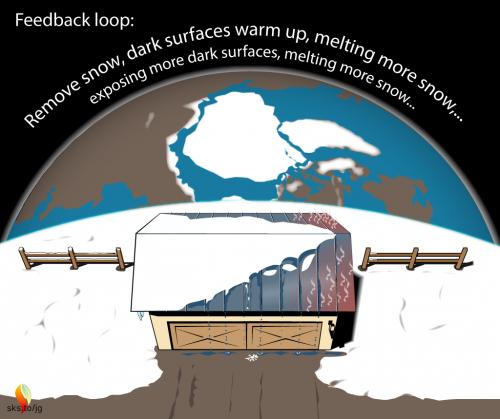
With many feet of snow on our shed roof and with another winter storm approaching, I knew I had to get some of the snow off the roof to prevent its collapse. So, I worked for a couple of days pulling off some of the snow. When I finished there was a thin layer of remaining snow over most of the roof, and the sheet metal at the edge of the roof was exposed, bare metal.
In the following days I noticed that the amount of bare metal kept getting bigger and bigger, moving up from the edge of the roof towards the peak of the roof. This did not happen with a nice, uniform layer of snow on the roof, all the way down to the edge. For months the snow had not retreated, but once I exposed the edge of the tin roof, the snow started retreating, exposing the tin roof as the snow line proceeded on its upward march towards the peak of the roof.
Of course, you know what was happening. White snow reflects most of the sunlight, keeping the snow cool. But when even a sliver of metal roof is cleared of snow, the sunlight hits it, warming it up, because the tin roof absorbs most of the sunlight. Now that the tin is warm, the snow next to the tin melts, causing more tin to be exposed, causing the larger amount of exposed tin to absorb more heat, etc. What started as only a sliver of metal exposed on the edges and a small amount of melting, soon turned into a rapidly increasing fraction of the roof being cleared of snow, accelerating the local warming and the melting of snow. Before long the snow on the shed roof had melted all the way to the peak of the roof and cleared itself off.

This phenomenon is called the ice-albedo feedback. “Albedo” is a fancy term that essentially means how white something is. Snow has a high albedo, and blacktop has an albedo near 0. Surfaces with high albedo reflect most of the sunlight, whereas surfaces with low albedo absorb most of the sunlight. The idea of the ice-albedo feedback is that when snow is sitting on top of something that has a low albedo, like the snow on our tin roof or like the ice on top of the Arctic ocean, the dark surface near the ice melts more ice or snow, which exposes more dark surface underneath, which causes more warming, which melts more ice or snow, and so on and so forth until soon a large area of snow or ice is melted. One of the only things that interrupts this process is that at some point the sun sets, allowing the environment to cool. This interrupts the ice-albedo feedback because the sunlight that drives the warming is not available during polar night. In Minnesota the sun rises and sets once a day, but in the Arctic there is a period when the sun sets and does not rise again for many months, just as there is also a period when the sun never sets, allowing the ice-albedo feedback to proceed unchecked for months at a time.
Why does this snow-clearing effect not keep our shed roof clear all winter long, and why did this ice-albedo feedback not cause massive ice loss in the Arctic 100 years ago? Sun shining on dark waters or on a shed roof causes heating, but if there are other processes causing more cooling than warming, then the overall system will cool. Ultimately whether ice melts or water freezes depends on the balance of many competing heating and cooling processes. The ice-albedo feedback mechanism simply describes an acceleration once melting has begun. But the overall heat transfer processes must allow melting to begin before the ice-albedo feedback process can accelerate the melting.
Because of this ice-albedo feedback mechanism the Arctic is warming at least twice as fast as elsewhere on Earth, because where ice is removed to expose a dark surface underneath, the environment goes from stable cooling to stable heating. This dramatic shift from cooling to heating is much of what is causing the Arctic to rapidly warm. Read here, here, and here.
This is a problem partly because the Arctic provides a source of global warming on steroids, and therefore a strong, localized source of intense warming. This extreme Arctic warming is also a problem because maintaining stable weather patterns in the Northern Hemisphere requires maintaining reliably cold temperatures in the Arctic. As the Arctic warms faster than elsewhere on Earth, the global circulation patterns are disrupted, affecting the motion of the jet stream. Because the jet stream controls weather systems in the Northern Hemisphere, Arctic warming is at the source of much of the recent disruption of our weather patterns according to the following effects.
Although the ice-albedo feedback primarily occurs in the Arctic, because of its influence on the jet stream, its effects are felt all over the Earth.
Posted by Evan on Tuesday, 17 December, 2019
 |
The Skeptical Science website by Skeptical Science is licensed under a Creative Commons Attribution 3.0 Unported License. |